2015 in Relief: Thom & Tom
Introduction
Sorry to be posting this final leg of my 2015 recap in late January, but Thom and Tom just got hung. Both are oversize woodcuts and required an assist from Trudi Ludwig Johnson to hang them in my office, where her Prima Veritas woodcut presides above a row of skeletal prints. (To see her print and its hanging, please go to my blog post: http://www.scottponemone.com/trudi-ludwig-johnson-mission-accomplished/) Thom Shaw, a Cincinnati artist who passed away in 2010, created one of the mammoth woodcuts, and Tom Huck, a St. Louis artist who’s actively turning out woodcuts at his Evil Prints press, made the other.
This recap is devoted to relief prints, starting with Thom and Tom, then two wordless narrative books, and finally three small prints.
The other two 2015 recap posts at my ART I SEE blog are:
● An in-depth look at a Joseph Leboit etching and aquatint: http://www.scottponemone.com/joseph-leboit-before-tranquility/
● A discussion of decorative arts accessions focusing on six John Swint-signed chairs: http://www.scottponemone.com/2015-recap-decorative-arts/
THOM SHAW
I was completely unaware of Thom Shaw until Main Auction Galleries held a sale of the entire Shaw estate–drawings, paintings, relief prints and their blocks–on Sunday, May 17, 2015. If the article in City Beat, an online journal, reflects the importance of Shaw’s work and the affection his hometown had for him, then it’s a great shame his life was cut short from complications from diabetes. (See: http://citybeat.com/cincinnati/article-21305-life_as_art_thom_shaw.html) A more intimate view of Shaw appeared in a 2009 issue of Cincinnati Magazine: http://www.cincinnatimagazine.com/citywiseblog/dead-man-working1/
I certainly was smitten by his powerful relief prints that often addressed his feelings about how African Americans are mistreated by the white culture (with Malcolm X often as a stand-in for all black males) as well as about cruelty and abuse within the African American community. The scale–about 50″ x 36″–of many of his prints added to their power.
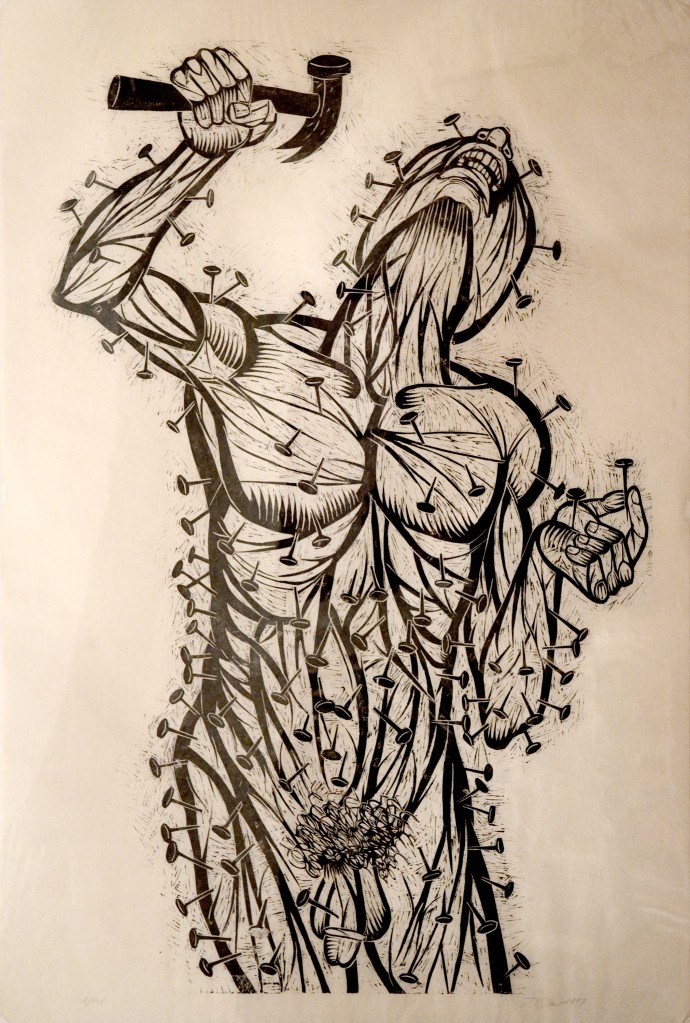
Thom Shaw (American, 1947-2010), untitled, woodcut, 1997, 51.5″ x 35″, 1997, a/p 1.
When I first saw this image online, I immediately thought of Rosemary Feit Covey’s wood engraving Ndonke, which I obtained in trade with Rosemary. (See my ART I SEE post: http://www.scottponemone.com/rosemary-feit-covey-printmakers-journey/)
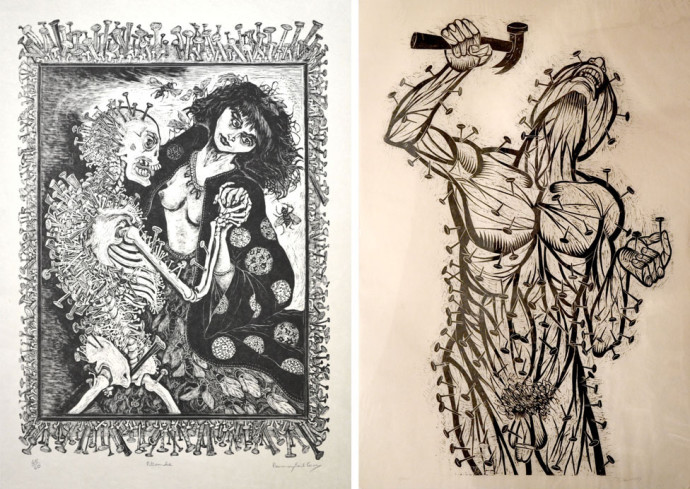
(left) Rosemary Feit Covey (South African), Nkonde, wood engraving, 1996, 14″ x 10″, 45/60.
It’s all the nails, obviously, that linked the two in my mind. Whether Shaw had in mind the nail-studded African wood effigies that Covey referenced in her danse macabre, I cannot say. Or was Shaw imagining a St. Sebastian of self-abuse?
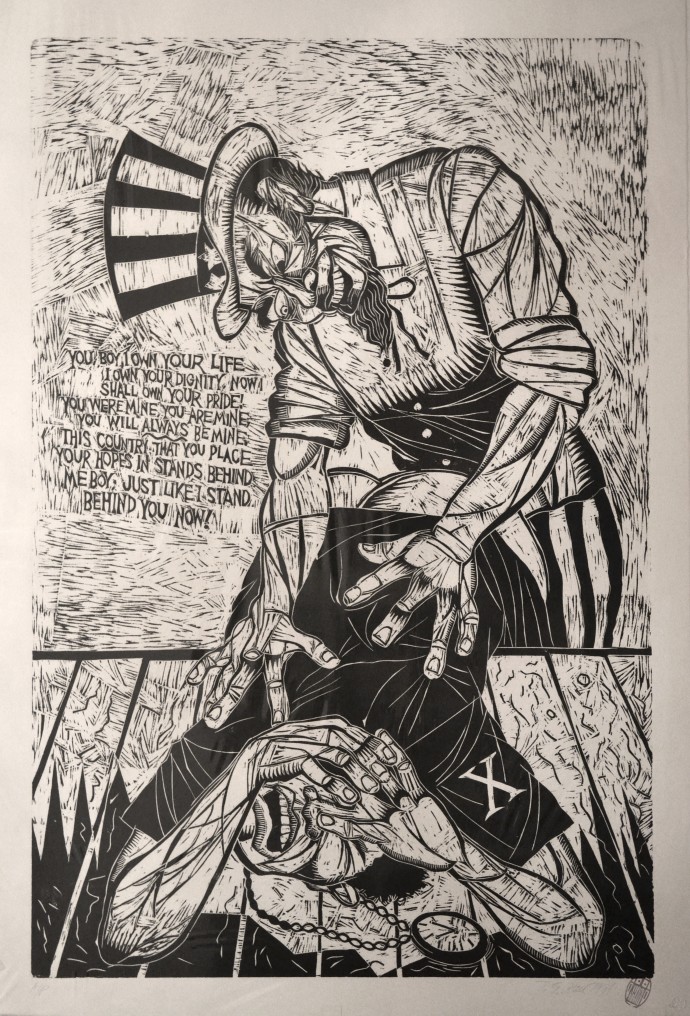
Thom Shaw, Malcolm X, woodcut, 1995, 52″ x 36, a/p (with artist chop, lower left)
I also won the bidding on this emotionally charged image (try reading the text), but I had no intention on keeping it. I bought it as a gift to the Baltimore Museum of Art. I wanted to challenge the curators to accept this print just a few weeks after Baltimore’s raw spring. Fortunately I can report the BMA met the challenge.
TOM HUCK
If it wasn’t for eBay, I’d have none of Tom Huck’s audacious (might I say, outrageous) prints. I recently described them as “silly gross.” Better yet, here’s how David Lancaster described Huck’s work last spring: “Huck calls his imagery ‘rural satire,’ a rather tame spin on the violent, scatological, sexual, grotesque, fantastic, funny and sensationally compelling visions he carves into giant slabs of plywood. …” (http://www.wheretraveler.com/st-louis/st-louis-tom-hucks-evil-prints-are-good-good-good)

Tom Huck (American, born 1971), Hedgeapple Warfare, woodcut, 2005, 12 1/4” x 40”, a/p
The first Huck was a 2007 benefit sale on eBay for a nonprofit called Space 1026 in Philadelphia. It’s All-American mayhem, like a tailgate party gone bonkers. While keeping with my strong interest in relief printing, it’s so different in tone to the heart-felt social realism expressed in many of the prints in my collection from the Great Depression.
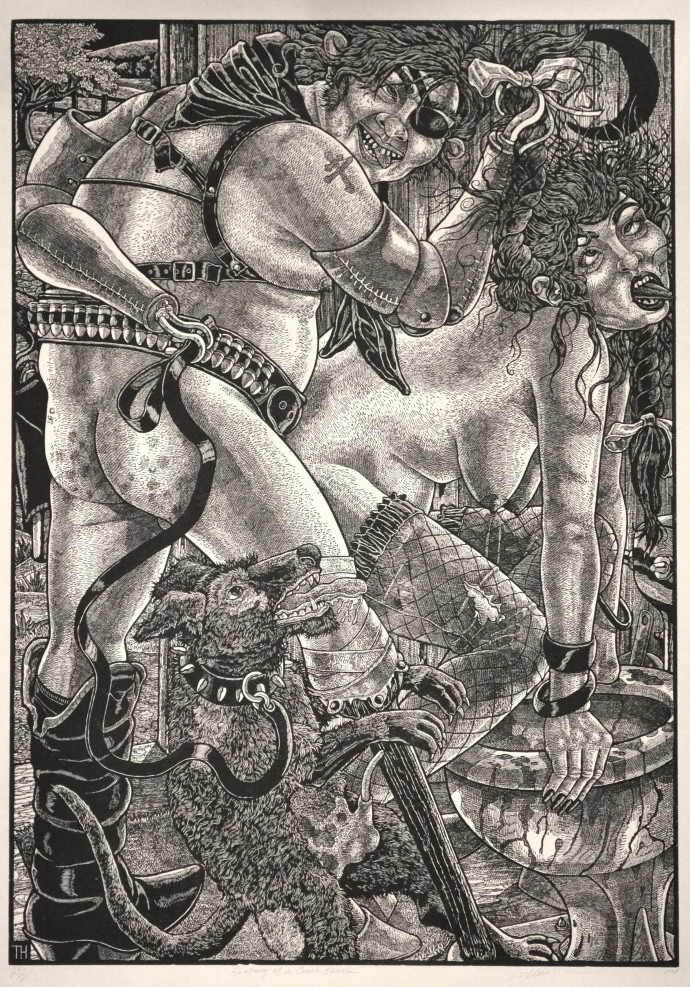
Tom Huck (American, born 1971), Anatomy of a Crack Shack, woodcut, 2004, 52″ x 38” (paper size, 2″ borders), 23/25.
Last December two huge Huck prints appeared on eBay. One of the prints was as densely populated as Hedgeapple Warfare, and the other was bold and obvious. In fact the relationship between the two human figures in it was–to put it mildly–similar to that in Shaw’s Malcolm X. (Imagine me offering two butt-fuck prints to the BMA?) Anatomy of a Crack Shack is from his Bloody Bucket series. (See http://evilprints.com/site/?page_id=168) Since I was planning to hang any new Huck high on my office wall, an in-your-face image was preferable.
Actually I attempted to purchased the other as a BMA gift. I even sent the curators an image to see if it would be accepted. And they did. But financially I couldn’t swing it, not with semi-annual property taxes due December 31.
Tom & thom Hang ups
The sizes of the Shaw and Huck prints would have been off-putting had I not had the history of hanging Trudi’s skeletal woodcuts early last year. Using magnetic tape and neodymium disc magnets, we hung her wonderful Prima Veritas and The Exposure of Luxury woodcuts without frames or glazing. So guess whom I called upon this month to help hang the Shaw and new Huck?
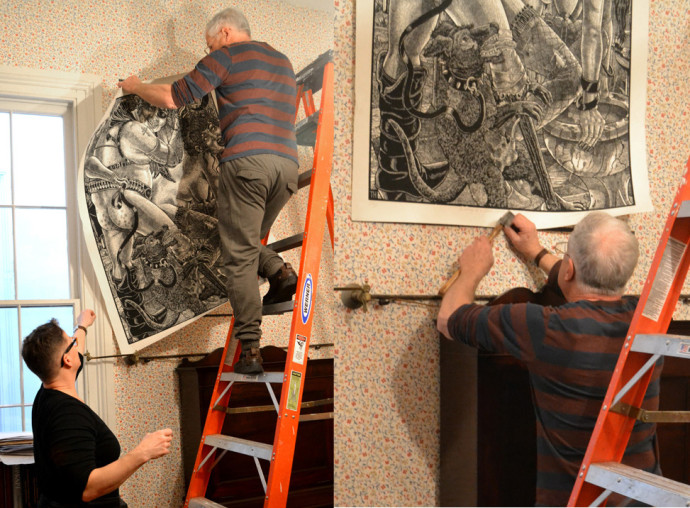
First we hung the Huck above my desk. Its heavy paper was too muscular for the magnets alone. So (in the photo right) I tapped in a few brads before I placed the magnets. (Photos by Michael Frommeyer)
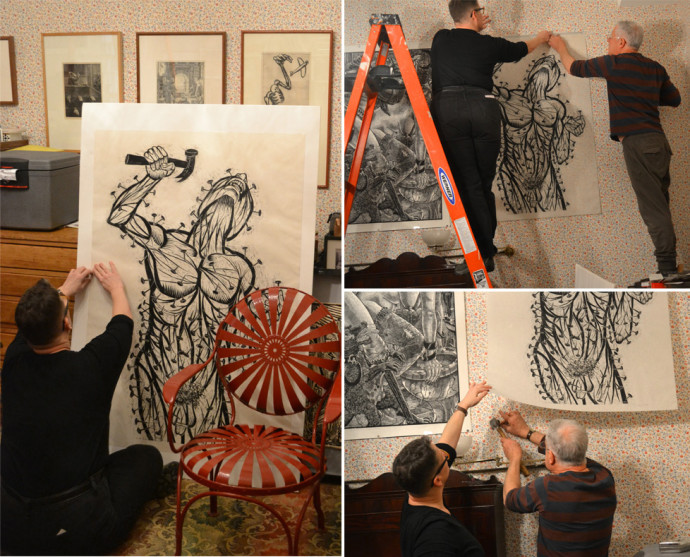
Then Trudi unwrapped the Shaw. Its more delicate paper received the magnets without an assist from nails.
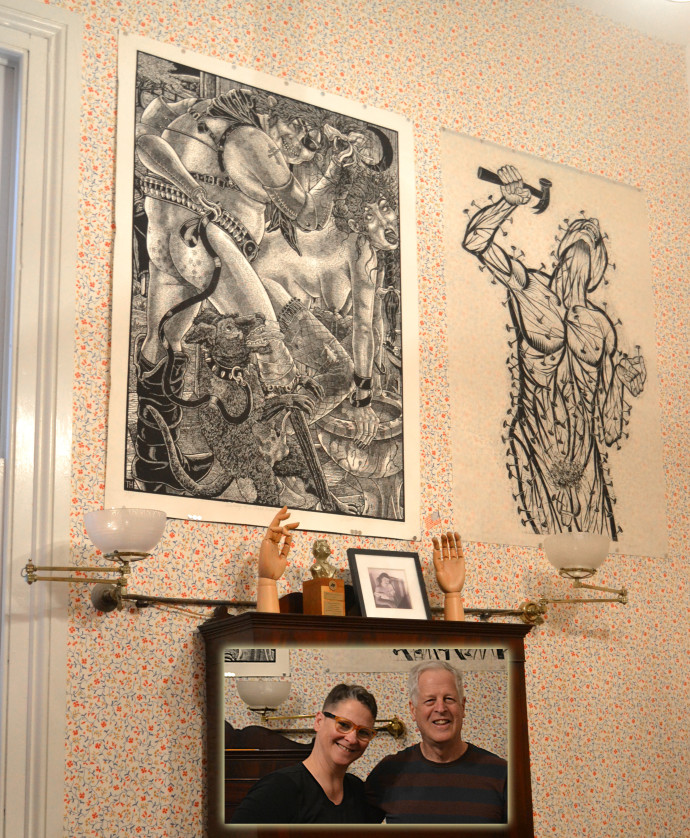
And there we are. Project complete.
2015 recap: BOOKS
It was an important year for adding to my small book collection that features wordless books, particularly those that tell stories in relief prints. Previous ART I SEE posts described the 2015 purchases of a limited edition of Lynd Ward’s Gods’ Man (http://www.scottponemone.com/letter-from-lynd-ward/), George Walker’s Book of Hours ( http://www.scottponemone.com/walker-berg-updates-on-wordless-novelists/), Paul Landacre’s California Hills and Other Wood Engravings and a very rare copy of Leon Underwood’s Animalia (http://www.scottponemone.com/picture-books-landacre-underwood-more-rossing/).
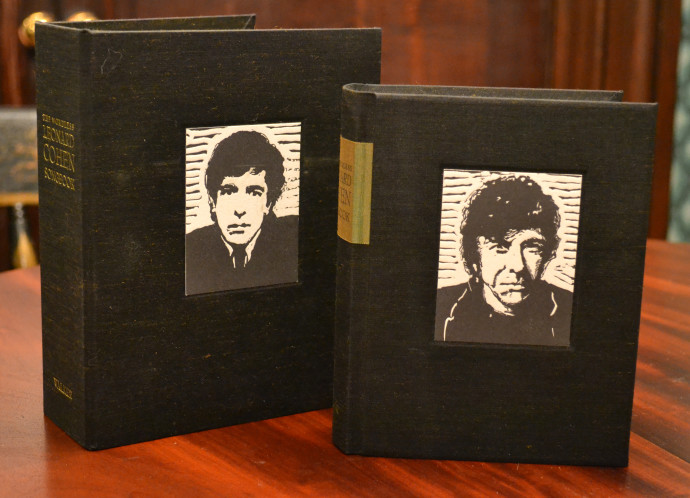
George Walkers, The Wordless Leonard Cohen Songbook, 2014, No. 24 in an edition of 80.
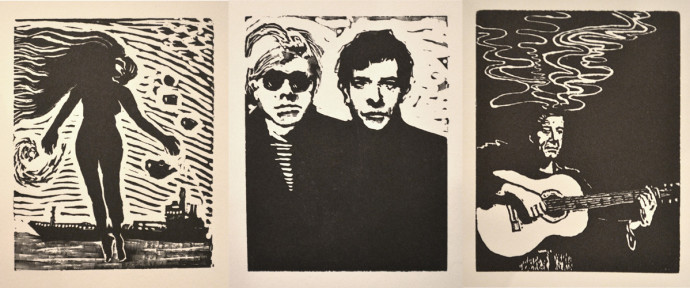
Here are three plates from Cohen, in no particular order. Is that Andy Warhol in the middle frame?
When I wrote about my visit to George Walker in Toronto, I failed to mention the purchase of his silk-bound edition of The Wordless Leonard Cohen Songbook. In keeping with Walker’s seeking out appropriate numbers, he commemorated Cohen’s 8oth birthday (Sept. 21, 2014) with a biography of 80 wood engravings and a limited edition on 80. Walker’s “tribute to his novels, poetry and music” is presented chronologically but in “a coded narrative.” Walker explains: “There is no single key to the reading of this book. Knowledge of people, places, and relationships in Leonard Cohen’s life will help readers recognize the images and show their significance, and I encourage you to bring to the narrative your own associations and recognition of the players and scenes.” Walker then gives a few hints involving the number 8. Otherwise it’s up to the reader–so unlike a Lynd Ward novel and its easily readable narrative.

Thanks to George Walker and our visit to him in Toronto, I was introduced to Englishman Neil Bousfield’s marvelous 2007 wordless novel The Cycle. George had a signed copy of the second edition printed from the blocks. On first viewing it immediately was a must-have. I purposely didn’t attempt to read it, saving that pleasure until I could secure a copy for myself. When I went to Bousfield’s website (http://www.inkyfingerspress.com/), I read that “the The Cycle took me 2 years to complete and I made only 12 copies, hand printed and bound by myself, for the first edition.” So I emailed him and learned from Clair, his partner, that the second edition had sold out. “However,” she wrote, “Neil collaborated with a printer who published a 3rd edition of 150 [actually 129], hard-backed, professionally bound, and this edition has also been printed from the original blocks.” The price was right, but the transaction took nearly six months as I tried and tried to circumvent fees for currency exchange. Finally I convince the Bousfield to set up a PayPal account, and the deed was done.
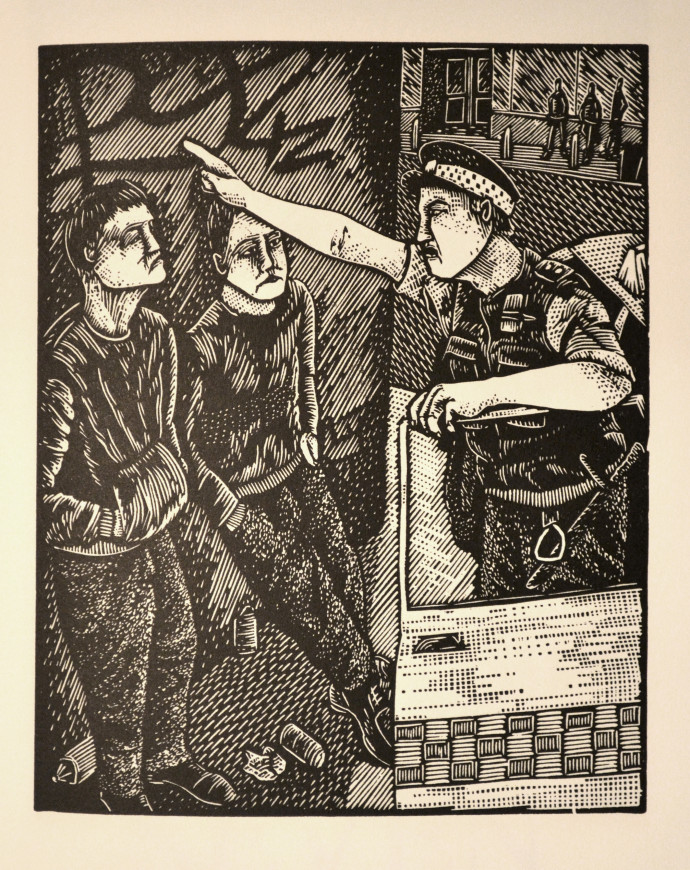
Like a Lynd Ward novel, The Cycle is a readable sequence of images. In his preface, Bousfield says this novel harkens back to his days as an animated film maker. “Once again,” he writes, “I am working with a sequence of images, only this time the images are contained within a book rather than on a screen.” The title refers to how one generation can repeat the mistakes of the preceding one. The book follows two brothers being raised by “a couple stuck in low-paying, soul-destroying work” where “feelings of failure and resentment turn to a need to escape through drink, drugs, gambling or shopping.” As young adults “they repeat their father’s example for their own escape and thrills.” Can either brother escape the cycle? You read the book to find out.
Regardless of how the tale enfolds, one thing you notice immediately is how much work it took to create each block, measuring 5 13/16″ 4 11/16″ (14.8 cm x 12 cm). There are 200 plates including chapter headings. No wonder Bousfield writes: “The book took two and a half years to make and six months was spent planning, storyboarding, making a mock up and drawing the images.” In the colophon, Bousfield notes that the images were engraved on vinyl. Of the wordless novels I’ve come to own only the plates (linoleum) in Giacomo Patri’s White Collar approaches The Cycle for scale and complexity of design.
2015 recap: Small PRINTS
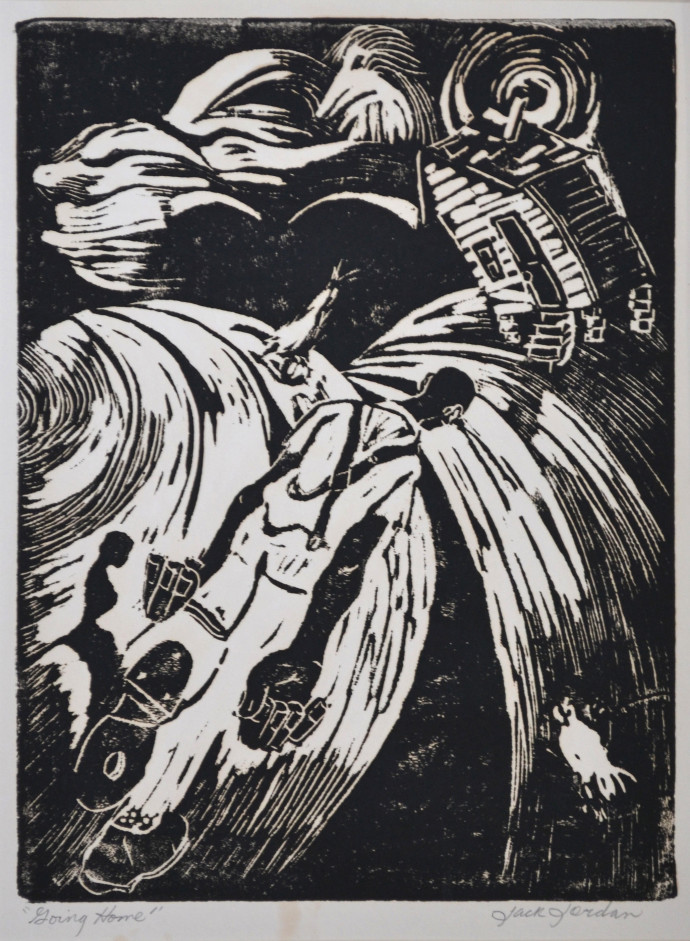
Jack Jordan (American, 1925-1999), Going Home, Woodcut, edition unknown, maybe late 1940s, 12″ x 9″
Illustrated in my post on Ruth Starr Rose (http://www.scottponemone.com/barbara-paca-rescuing-ruth-starr-rose/), this print came my way via eBay. The askART website listing says: “An African-American sculptor, painter, graphic artist and art educator, Jack Jordan was Professor of Art at Southern University in New Orleans. He also served on the State of Louisiana Commission of Creative and Performing Arts. Jordan received a B.A. degree in 1948 from Langston University in Langston, Oklahoma; an M.A. in 1949 from Iowa State University, and an M.F.A. degree in 1953 from the University of Iowa.”
I hadn’t seen this image for many years since at an print fair I advised a curator for the Baltimore Museum of Art to purchase that copy for the Museum. I thought the BMA copy had a second color (perhaps red) in the sky, but when an assistant for the Print, Drawing & Photograph Department emailed me an image of its copy, it looked like mine.
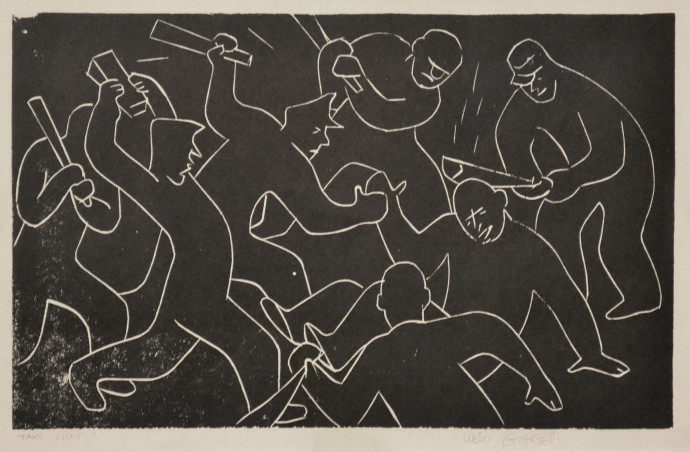 Guido “Wedo” Georgetti (Italian-born American, 1911-2005), Take That!!, relief print, edition unknown, 6 1/4″ x 9 3/4″
Guido “Wedo” Georgetti (Italian-born American, 1911-2005), Take That!!, relief print, edition unknown, 6 1/4″ x 9 3/4″
Here’s another eBay purchase and an even more obscure printmaker. From askART: “Born in Marche, Italy on May 19, 1911, ‘Wedo’ Georgetti came to America at age one. After a brief period in St Paul, the family settled in Tacoma, Washington. He grew up, attended high school, and began to study art there. After moving to California in 1934, he shipped out of San Francisco as a merchant seaman for many years. Visiting the ports of the world, Georgetti obtained much of his subject matter from his travels. Working in oil and watercolor, he painted many nudes and street scenes. He lived in Sausalito on San Francisco Bay until his death on December 12, 2005.”
It seemed somehow propitious that this print was offered on eBay soon after the Baltimore unrest.
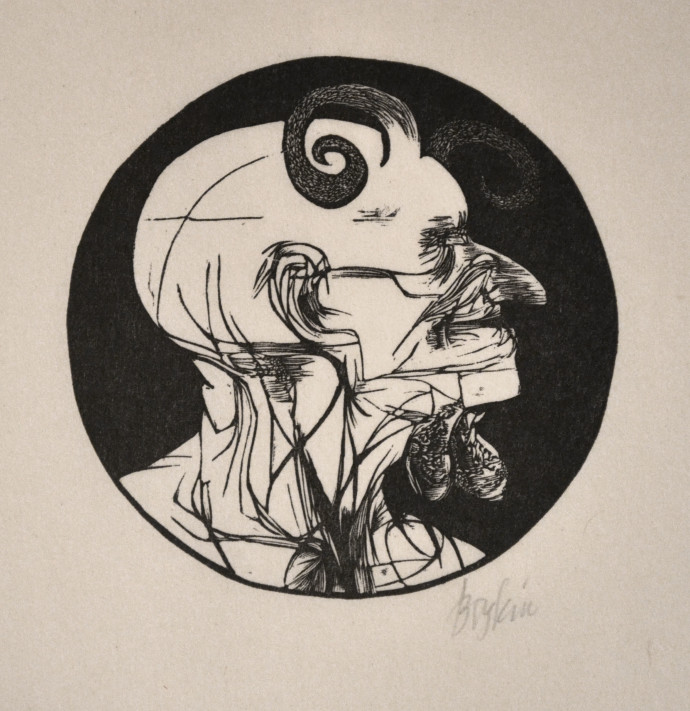
Lastly, another inexpensive eBay purchase. Well-known artist and printmaker Leonard Baskin (American, 1922-2000) did a book of the Seven Deadly Sins for Gehenna Press in 1958. I bought three signed proofs from the set as a birthday gift for my partner (now spouse) Michael Frommeyer in 2002. Now joining Pride, Gluttony and Lust is Envy, wood engraving, 3 1/4″ round.
ADDENDUM
I never thought there’d be a price to pay for blogging. Now I know there is.
While writing about the purchase of the Tom Huck print (in Jan. 2016), I decided it seemed appropriate to recontact the seller and see if he would honor that price he had offered in December for the second huge Huck woodcut–Pork Chop Suey – Oinktoberfest–that was printed at Landfall Press in Santa Fe, NM, in 2007. He would. And PayPal made for a quick, decisive decision. Within a few days I couldn’t hold back my excitement. In a P.S. to an email to a Baltimore Museum of Art curator, I wrote, “The Huck in on its way.”
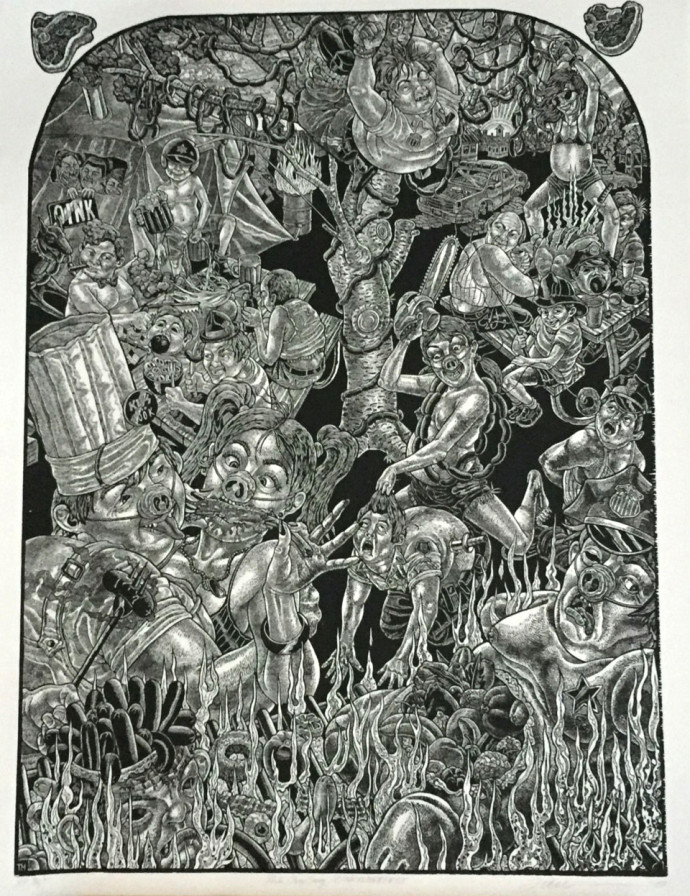
Tom Huck (American, born 1971), Pork Chop Suey – Oinktoberfest, woodcut, 2007, 52″ x 39 1/2″, AP 3/3 (Landfall Press printed an edition of 20)
It arrived as requested rolled up in a sturdy cardboard tube. I laid it out on a homasote board, thumbtacks around its perimeter. I got to enjoy it for a week before a museum courier rolled it back up and took it away.
It turns out I can be a bit generous with artwork that I never intend to add to my collection. Plus I have a tax write-off for year 2016.
Trackback URL: https://www.scottponemone.com/final-2015-recap-tom-thom/trackback/












You definitely have an eye for the dark side, much as I do–I am so glad the BMA has accepted these works or the work that you could afford.